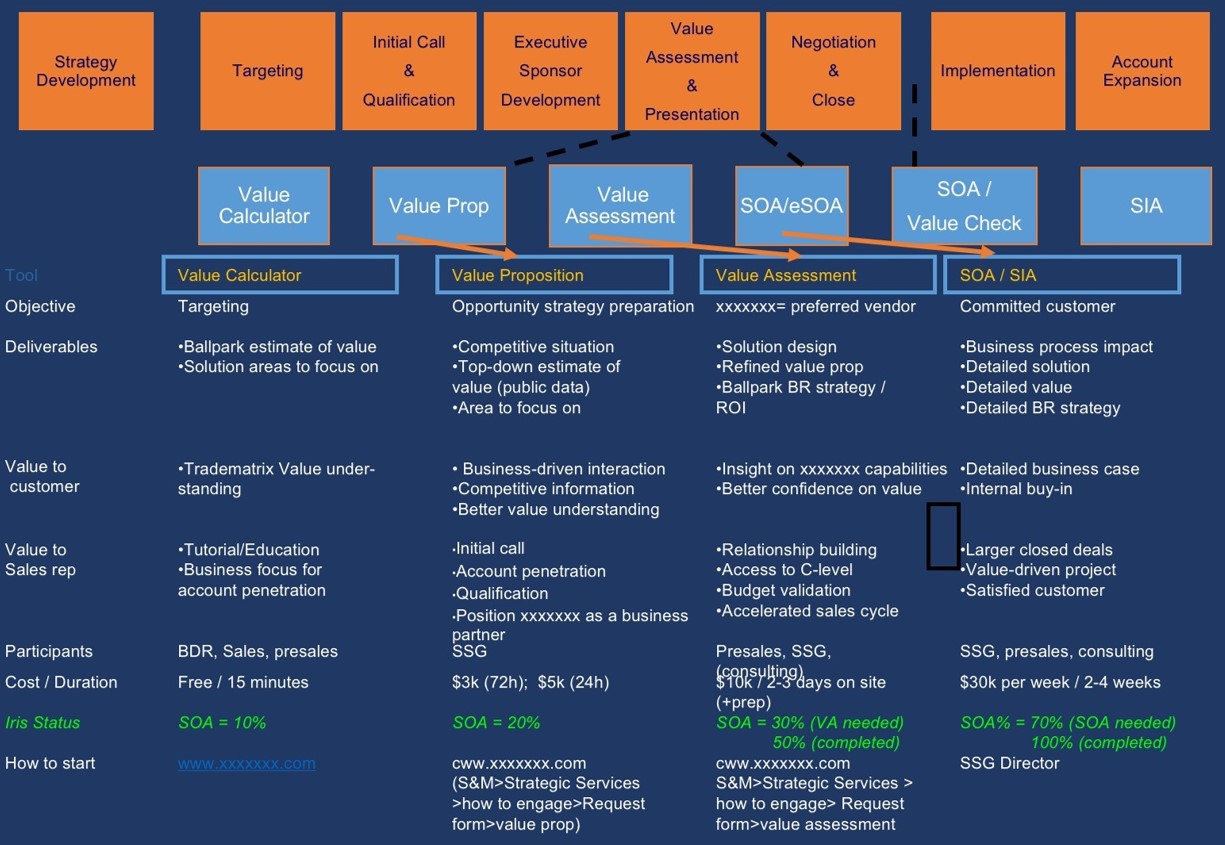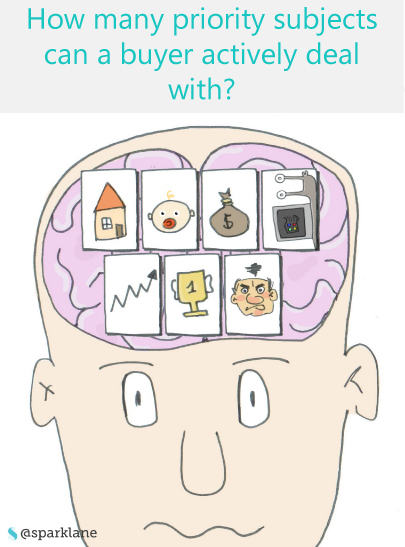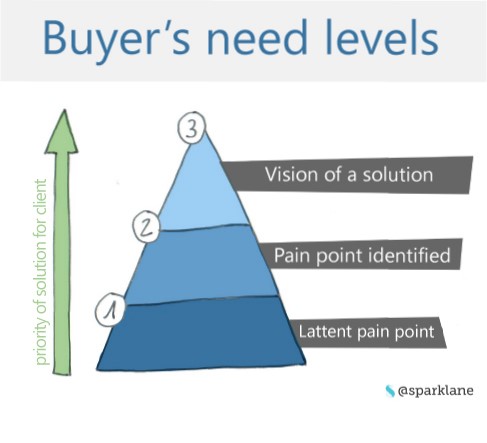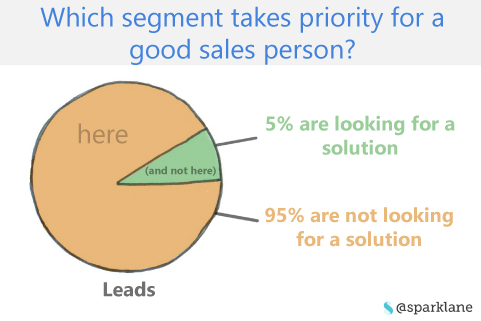24 March 2021
60% of salespeople assisted by AI and automation by 2021
AI and automation will be a staple of the B2B sales processs according to Forrester. Sales Enablement is booming in the US,…
23 November 2017
Solution Selling is a complex sales method notably used in the high-tech world and that is very dear to me. It has even paced my work of the past 10 years. Solution Selling (as in selling “by” solutions, and not the selling “of” solutions) is a sophisticated method invented by Michael Bosworth in 1982. It remains fashionable today, even if it is no panacea (no method can claim to be). I have seen American publishers develop real commercial war machines through this method, by focusing on one form of central data: the client pain point.
To be sure of the existence of this pain point, the sales person is equipped with a lethal weapon: the question “what keeps you up at night?” So they put on a different hat and become a marketer, or indeed a consultant. For example, they propose an audit known as “SOA” (Strategic Opportunity Assessment) and if, at the end of the audit, the client accepts their solution, then this preliminary phase is free. If not, then they pay for the audit and there the matter ends.

However, in this case, the sales person will have at least achieved something: uncovered the famed client pain point. Following our recommendations (well, above all, those of my friend and former boss Bernard Molland, a great sales and IT visionary), Orange Business Services implemented this method for half of the 2000s. The methodology was renamed “selling by value” for the occasion (since it was combined with some other methods).
In the space of a few months, after the systematic training of their key accounts sales team, I saw the philosophy and quality level of Orange Business Services’ sales considerably increase. This episode of transformation was not uninvolved with the B2B operator’s change into a service provider: over 3,000 people to date, with impressive growth.
In our previous article about the Selling Fox, we addressed the difficulty of the sales person, who, like in the jungle, has to make a place for themselves among their competitors and hunt efficiently in order to survive. An additional burden, the reputation of the sales person, is added to this professional hazard.

There is a shared vision of sales people, regardless of the country or the culture: the buyer sees the sales person as a “Joe Isuzu”, the advertising character representing Isuzu Cars & Trucks. He is the archetype of the vicious sales person capable of using every possible trick in the book to hit their targets: his catchphrase is “If I’m lying, may lightning hit my mother!” (as the phrase “Good luck, Mom!” appears on screen). This is the profile a buyer is thinking about when he deals with a sales person, whether or not they are familiar with the advertising character.
“People don’t like to be sold, but they love to buy” (Jeffrey Gitomer)
People don’t like to be sold, but they love to buy and this means that once a sales person knocks at their door, they are already preceded by the (bad) reputation of their colleagues. The buyer is suspicious and the sales person is found guilty before they can even speak. Instead of selling like Isuzu, Michael Bosworth thinks, through his Solution Selling method, that the seller should attempt to understand the pain points of the buyer (like in SPIN Selling, from which he drew inspiration). Once the diagnosis has been given, they will find a suitable solution that will satisfy the client.
For Michael Bosworth, each client has a need, whether this is so present that it keeps them awake at night, or is buried or forgotten. No skilled sales person will propose a solution until the need has been expressed: so they have to analyse where the client’s need is located and how to bring it out. This need correlates to the client’s pain point, a notion central to Bosworth’s theory.

According to Bosworth, the human brain functions like a computer, running foreground and background tasks. He believes that the limit of the tasks on which we can constantly focus our attention is around seven. Above this figure, the least important tasks are relegated to the background and forgotten. So a buyer who has a problem to deal with will see the proposed solution differently depending on whether or not this problem is in the 7 available “slots”. So selling a solution varies according to the state of the client and the level of priority they give to their needs. Michael Bosworth ranks the client’s need levels in a three-floor pyramid:


On the second floor of the pyramid, the buyer is aware of their problem and wants to solve it. They are dissatisfied with the existing solution and are actively looking for another one. If they give up on finding the solution, they will find themselves in the first situation with a latent need.
At the summit of the pyramid, the buyer knows which solution they have to adopt. They have clearly defined their needs and know which response to use: this is therefore the easiest scenario for the sales person. But is it really? Michael Bosworth warns us: effectively, it’s tempting to reply to the client who comes to you saying “I need that and that” with “very well, here you are.” This is the same as giving out medicine without a prescription, as validating a solution without having studied the problem. It is crucial to think diagnosis before you think solution, as it’s by extensively analysing the client’s situation and finding the solution that will relieve them of their preoccupations that you will earn their loyalty.
A good sales person should be able to recognise a client that is in one of these three phases: but how do you get them out of the first stage? How do you uncover a latent need and place it among the seven preoccupations prioritised by the client?
For Bosworth, you can only bring a solution if you create the hope of resolving a problem. To illustrate this, he uses the example of baldness. Baldness is the typical example (among those people affected) of a latent need. It exists and the person suffering from this problem is aware of it, but has given up on resolving it because there is no solution at the moment. However, if a newspaper suddenly runs the headline “Remedy against baldness finally found!”, the subject will immediately find itself among the buyer’s priorities. They don’t know who sells the solution, they don’t know how much they’re going to have to spend or if this solution is on the market. But they are going to actively think about the subject because there is a hope of resolving their pain point. And for Bosworth, it’s up to the marketing team to create the hope with the buyer.

The diagram above shows how Bosworth sees the market: 5% of clients are looking for a solution, and the rest, the immense majority, are living with their latent need. For him, most sales people consider these 5% as their sales zone and devote their energy and marketing budget to this percentage of targeted people. Bosworth thinks that if these 5% are looking for a solution, it’s because a sales person has already made them aware of their need. In other words, advising someone who has already chosen their solution is like helping your competitor close their deal.
So the targeting has to focus on the remaining 95%, although this may seem counter-intuitive. The sign that Bosworth was a visionary is that, at the time, Big Data didn’t exist, so attempting the prospecting of this majority of leads was more difficult to undertake than it is today. With Big Data, Solution Selling applies even better to our era than to the 1980s.
In fact, Sales Automation tools (such as Sparklane) can collect client data from this famed 95% and detect their business signals. A signal is an event that takes place in a company and, from the outside, may signify the emergence of a new need. For example, a training body may detect a company recruitment drive as an important business signal because the new employees may need support. An insurance company will see a business signal in the establishment of a subsidiary or purchase of new premises by a company. These leads will have a need at a specific moment, and Sales Intelligence will enable the sales person to detect this forthcoming client pain point even before the buyer has envisaged a solution.
I explained at the start of the article that Bosworth’s method had played a particular role in my work over the past years. This is not only true at a commercial level but also, and above all, at a digital level. And it continues to be so, because this method is a real potential commercial workshop.
Solution Selling is indeed entirely transposable to the Web and this is easy to understand. In B2B, Web visitors are also looking online for responses to their client pain points. By searching on Google, they hope to find solutions to their problems, if the solutions exist:
I have used this method time and time again to launch new social media and content marketing projects. If we add to this my comment above related to Big Data, we clearly see that Solution Selling is perfectly adapted to this digital era in which we are currently living and for the many years to come.